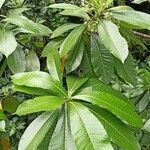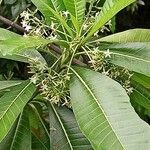Small or big tree 3-40(-50) m high, 5-100 cm dbh, buttresses usually absent or small up to 1 m high and spreading up to 2 m at the base. Bark smooth or rough, minutely scaly, shallowly longitudinally fissured or both longitudinally and horizontally fissured, silver grey to dark brown; inner bark brittle, hard, creamy, yellowish brown with cream or orange streaks, whitish inside. Branchlets glabrous. Leaves in whorls of 3 or 4; petiole 2-25 mm long, colleters minute and densely packed together in the axils; blade chartaceous or coriaceous when dried, obovate or narrowly obovate, sometimes elliptic or narrowly elliptic, 4.5-25(-32) by 1.5-10.5 cm, 1.7-4.8(-5.8) times as long as wide, apex varies from rounded to narrowly acuminate, acumen up to 20 mm long with a blunt tip, base acute to decurrent onto the petiole, sometimes abruptly so, glabrous above, glabrous or densely pubescent beneath; 12-25(-31) pairs of secondary veins (short intermediate veins sometimes present), forming an angle of (45-)60-80(-90)° with the midrib, 3-15 mm from each other, sometimes joining near the margin forming a submarginal vein; tertiary venation reticulate, conspicuous beneath or sometimes on both sides. Inflorescence 2-11 cm long, many-flowered; pedicels (0-)1-4(-6) mm long, puberulous or glabrescent. Bracts and bracteoles sepal-or scale-like, ovate, triangular, up to 1.5(-2) mm long, obtuse or acute, ciliate, glabrous or puberulous outside, glabrous inside. Flowers fragrant. Sepals connate at the base for 0.5-0.8 mm, ovate or broadly ovate, sometimes turbinate, 1-2.5 by 0.8-1.8 mm, obtuse or rounded, sometimes mucronulate, ciliate, glabrous or puberulous outside, glabrous inside, erect or slightly spreading. Corolla lobes dextrorse; white or cream (sometimes pinkish on the tube), 5-12 mm long in the mature bud and forming an ovoid or narrowly ovoid head, 2-6 by 0.8-1.5 mm, glabrous or sparsely hairy around the stamens and on the lobed margins outside; tube 4-6.3 mm long, 0.9-1.8 mm wide around the stamens; lobes ovate or narrowly ovate, sometimes slightly falcate or oblique, (2.8-)3.6-7 by 1-2.6 mm, 2.2-5 times as long as wide, pilose at the base to over half the length of the lobes inside, ciliate (rarely not), apex rounded, auriculate at the base on the right side. Stamens inserted at 2.5-3.8(-4.1) mm from the base; anthers ovate, 0.8-1.5 by 0.3-0.6 mm, obtuse, sometimes acute or mucronulate. Pistil glabrous, 2.6-4.2 mm long; ovary ovoid (rarely broadly ovoid), (0.6-)0.8-1.4 by 0.7-1 mm, of 2 carpels, with an annular disk-like thickening at the base 0.2-0.4 mm high, mostly conspicuous; style 1.4-2.5(-2.9) mm long; style head ovoid 0.4-1 mm long, with a minute or narrow cleft stigmoid apical part 0.1-0.4 mm high. Fruit a pair of follicles, 25-62 cm by 2-4(-4.5) mm, glabrous. Seeds elliptic (sometimes slightly ovate), 5-10.5(-12) by 1.6-2.5 mm, pubescent on both sides, one end acuminate with an acumen 1-5 mm long (sometimes bifid at the apex), the other end rounded (rarely obtuse); longest cilia 5-10 mm long, becoming gradually shorter along the margins.
More
Trees to 20 m tall. Bark smooth; branches nearly 4-angled. Leaves in whorls of 3 or 4; petiole 1-4 cm; leaf blade narrowly obovate or narrowly elliptic, 10-53 X 4-19 cm, leathery, pubescent abaxially, apex usually acuminate; lateral veins 16-33 pairs, at 60-70° to midvein. Cymes terminal, 3-branched, 5-9 together, pubescent; peduncle 4-6 cm. Pedicel 4-5 mm. Corolla tube slightly longer than lobes, 4.5-6 mm; lobes overlapping to right, ciliate; disc absent. Ovaries distinct, glabrous. Follicles linear, to 61 cm X 2-5 mm. Seeds pubescent, ends with deltoid wings, with long stiff hairs all around. Fl. Oct-Nov. 2n = 22.
A tree. It grows 20 m tall. The bark is smooth. The branches are angled. The leaves are in rings of 3 or 4. They are 10-53 cm long by 4-19 cm wide. They are hairy underneath. The flowers are at the ends of branches.



